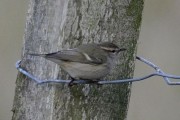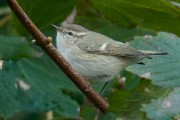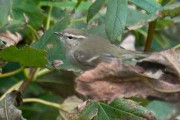Hume’s Warbler, Valyie, Unst – 16/10/12
Posted by Brydon Thomason on Thursday 1st November 2012 | Birding in Shetland
It had been many weeks since I had caught up with Paul Harvey and even longer since we had been birding together so with a day freed up to spend birding Unst on the 16th October, we set out full of optimism. With a generous scattering of October scarce and rare migrants over the past few days and conditions being favourable for more, we felt that our optimism was not misplaced.
But the reality is however, that the days where optimism is rewarded are greatly outnumbered by days of disappointment, but that’s what ‘the hunt’ is all about. This is of course one of the many advantages of birding as a team though; over and above the obvious advantage of an extra pair of eyes, company is good for morale.
At our first port of call our optimism was however rewarded with an Olive-Backed Pipit at Skaw, ‘that’ll do nicely’, we agreed although we couldn’t help hoping it would be our aperitif for something a little rarer. Barely an hour later we arrived at the rarity renowned hotspot of Valyie at the northern end of Unst. This mature wooded garden (by Shetland standards that is) is surprisingly difficult to work on your own but working together as a team you stand a much better chance of good coverage. With Paul on the outside I worked my way through the inside.
On nearing the bottom end of the garden, from just beyond a dense canopy of sycamore I could hear a faint and very intriguing call which sounded familiar enough to me to think it from a phyloscapus warbler but yet I couldn’t place which; a soft single ‘Siberian Chiffchaff’ like note (already heard earlier that morning), repeated three to four times followed by a more Siskin like disyllabic call. So momentarily perplexed was I that I even called Paul who I thought might be ‘at it’ with the iPod again, as he had been earlier in the day by playing calls off of ‘Eastern Vagrants’! But Paul was out of earshot. Just seconds later I heard the call again, prompting me to leave the trees and find Paul.
We discussed the call and I mentioned perhaps a Pallas’s warbler, more by associating the call with what I thought that species sounded like as apposed thinking it sounded like one (I have yet to actually hear one in Britain). Hume’s was also mentioned but these calls didn’t fit for what I was familiar with for that species. While waiting for the bird to show Paul played Pallas’ and Hume’s calls from the iPod, ever hopeful l (!), but there was no response. However although the Pallas’s call from the trusted iPod sounded similar, more importantly one of the three Hume’s calls was also a close fit and known to be similar.
Again the benefits of team work in these situations are invaluable both for the ID process and combined input and to piece together and process the identification. A brief glimpse of the bird fly catching as it flit between sycamore canopies was enough for us to see it was clearly a Yellow-browed type. After a brief glimpse of the bird we both enjoyed better views. Its dingy plumage, blackish bare parts and what looked like only one fairly broad buffy-white wing bar (with the second barely noticeable) was enough for us to be confident it was indeed a Hume’s.
It was frustratingly difficult to get views of the bird, so realising it was working a circuit of the garden, and only showing at certain parts we decided to stay close to what appeared to be its favourite feeding area. On our next view we confirmed the features above and then heard it calling several times and I also managed to photograph it. There was no doubt it was a Hume’s Warbler. What was very interesting about this Hume’s was the set of calls it gave and how much they varied. The typical and diagnostic disyllabic call most associated with the species was only given twice that day and not until much later. The other two calls were a single note of an even pitch and a more Siskin-like call with some downward inflexion. All three call-types are actually given on the Eastern vagrants CD. Despite playing these calls, however, the bird never really responded. Initially locating this bird up on call is quite typical of how many good birds are found. It is perhaps not easy to familiarise yourself with all the calls of everything you hope to find but knowing that something is different to the norm is extremely helpful!
Funnily enough, the following day when I returned to see if it was still present, and before I even saw it, it gave the classic and typically disyllabic Hume’s call which I am more familiar with several times. After not being seen for a week it reappeared on the 24th.
This was only the second for Unst following the one we found in back in 2008 (on a more typical date in early November). This is by far the earliest record for the species in Shetland and only the fourth year it has been recorded here.




